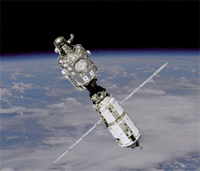Sex in Space: Physical Action and Reaction
Intimacy is important, and usually involves quite a lot of close contact. On earth that contact is held in place (literally) by gravity. Horizontal or vertical, your body is affected by gravity, and the friction that exists between the bed and your feet (or hands, or knees, or face, or pinky, whichever organ you use to balance yourself while you’re in the mood for dancin’) keeps you from moving anywhere other than where you intend to. In space, however, things are much different.
 In the past 50 years, humanity has made huge steps towards life in space, from landing on the moon to having astronauts spending months in the International Space Station. If (when) we send human beings to Mars, the trip itself will take about 7 months. Combined with some quality time on the surface (or in orbit) and a trip back, these types of missions can take a very long time.
In the past 50 years, humanity has made huge steps towards life in space, from landing on the moon to having astronauts spending months in the International Space Station. If (when) we send human beings to Mars, the trip itself will take about 7 months. Combined with some quality time on the surface (or in orbit) and a trip back, these types of missions can take a very long time.
Do we really expect our astronauts to spend years in space without any sort of intimate contact?
[blockquote class=”alignright”]It was Newton who stated that every action has an equal and opposite reaction. Usually that rule is very helpful. In this case – not so much.[/blockquote]There are space hotels planned for the (near?) future, and China has declared its intentions to conduct space weddings (for an inflated price). Do we really expect newlyweds – spacelyweds or earthlyweds – to give up their culturally given right to consumate their marriage?
So how would such an act (or acts) be conducted in a zero-gravity environment, inside a cramped compartment, with limited movement and the laws of Newton out of control?
Until this is tested we can only guess. And in this article, guess we shall.
Physics of Movement
It was Newton who stated that every action has an equal and opposite reaction. Usually that rule is very helpful. In this case – not so much.
The first physical principle we must examine when thinking of any sort of intimate interaction in space is collision. Wikipedia defines collision in a manner that seems quite fitting to our context (as well as the general ‘regular’ context, of course):
A collision is an isolated event in which two or more bodies (colliding bodies) exert relatively strong forces on each other for a relatively short time.
So a collision is an interaction between two moving bodies. There are generally two types of collisions – plastic and elastic.
Plastic vs. Elastic Collisions
A plastic collision is rigid – the two bodies will stick together and continue the movement together, as if they are one (combined) object. This, however, is not as romantic as it sounds – the collision itself causes the involved bodies to lose energy to the environment (in the form of heat, for example). Or, if the two bodies are human beings, it might result in bruising.
An elastic collision is bouncier, and results in less energy lost to the environment. It results in both colliding bodies moving in completely separate directions. The directions and angles can be calculated quite simply, if you know the velocity (speed and direction) and the mass of the objects. In fact you probably do that quite a lot – without thinking about it – if you play billiards.
Billiards, or pool, is a great example of seeing these types of collisions for yourself. Hitting a colored ball with the white ball at an angle will usually result in both objects moving in different directions. Sending the white ball softly towards the color ball, “head on”, would result in both balls moving together.
Capn Refsmmat (ScienceForums.net Administrator and “Quirk Side of the Moon” member) has a simple, easy and concise summary of the definition: “An elastic collision goes ‘Boing’. Plastic goes ‘Splat’“. Thank you, Cap’n.
Collisions in Space
In space the situation gets even more complex. Your bodies are not supported by anything at all, and you are at the mercy of whatever bulkheads (or ropes, if you’re into that sorta thing) you can grab ahold of. That can make intimacy a bit tricky. It’s enough to miscalculate a nudge, and you could send your partner flying to the other side of the room, while you do your best avoid the splat on the opposite wall. Talk about killing the mood.
Thrust in Space
Another concept in physical interaction and movement is thrust.
When talking about such intimate scenarios, the word “thrust” often comes up, and usually refers to strong forward movement. In physics, however, thrust is slightly different. It will indeed affect sex in space, but in a completely different way.
In physics, thrust is the reaction force that results when an object expels mass – for example, when a rocket shoots burning fuel out (and loses mass in the process). This follows Newton’s law that an action leads to an opposite reaction. The general principle behind rocket movement is that the energy of burning the fuel is pointed in the opposite direction to the movement. So if pointed backwards, it pushes the rocket forward.
Thrust in such intimate situation will, usually, take place at the conclusion of the act. Think of a rocket, spewing out a stream of heat and fuel, pushing the rocket forward. Now think of the pair of amorous astronauts as they conclude their act. The male, assuming he enjoyed himself fully, might be thrust backwards like a rocket, hopefully not colliding with anything in his way.
Perhaps it would be smart to cover the opposite wall with some cushions.
Possible Solutions?
NASA is the agency generally in charge of researching human (and other animal) behavior in space. They do a very good job in general, but whenever the question of intimacy in space is raised, their response is limited, to say the least. There is no research about sexuality in space, according to NASA. The Russians follow a similar protocol and usually choose not to respond to the question.
But the US and Russian space agencies are not the only organizations that deal with space physics questions. On September 13, 2008, the History Channel led a special experiment in zero-G for its documentary series “The Universe“. It featured novelist and inventor Vanna Bonta, and a special space suit she invented to “house” such intimate acts in space. The group manufactured the suit and then tested it during a zero-G flight.
The suit is made of two different space suits worn by the participants. When they want intimacy, the suits are “hooked” together and transform into a single – quite roomy – “pocket” where the couple can remain close to one another while engaged in passion. This might solve some of the problems with Newton’s laws going awry, at least by controlling the elastic collisions and preventing the individuals from moving away from one another.
So far NASA hasn’t picked it up for mass production, though.
Conclusion
As you can see, sex in space is quite tricky. Newton’s laws, however, are not the only problem for sex in space. Biological processes, chemical reactions, and perhaps many more accompanying phenomena can mean a universe of trouble for a couple interested in intimate interaction. In the next parts we will examine more of these aspects and try to see how they can be dealt with. All for future generations, of course, and all for science.
For now, I will leave you with a summarizing thought: If you still have doubts about the potential romance-wrecking effects of sex in space, imagine an amateur astronomer looking through his telescope at the International Space Station:
Further Resources
- “Sex in Space” by Laura Woodmansee, ISBN-13: 978-1894959445
Thanks to Laura Woodmansee, via Phil Plait (Bad Astronomy) for the extra resource!
[AMAZONPRODUCT=1894959442] - “Astronauts test sex in space – but did the earth move?“, The Guardian (UK)
- “Sex in Space” from Wikipedia (lots of interesting resources there)
- “The Uncomfortable Reality of Sex in Space“, Wired’s “Sex Drive” (Commentary by Regina Lynn)
- “Outer-space sex carries complications“, MSNBC about the new experiment with the 2suit.
- “Sex in Space“, Space.com
- “The Universe“, a History Channel documentary
Article picture courtesy of Rhys Bennett via Flickr
[notice class=”notice”]This article was originally posted on March 13th, 2009 on SmartAxe, which is now merged with “Explicitly SmarterThanThat, the Grownups Section“.[/notice]2 comments
Reply



The animation of the International Space Station rocking back and forth brings to mind a modification to an old phrase:
If the stations rocking, don’t come a docking : )
hmmmm. interesting article.